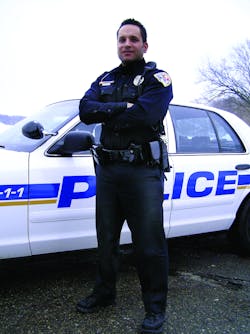It's one of those things no one gives much thought to until they are painfully made aware; the day is suddenly much longer, each step is agony and sitting in the squad car an absent comfort.
Ergonomics deals with more than an intuitive design of product (though that does hold major sway in solving the issue). Where the equipment is placed, how the gear is suspended, and how the gear is used on a daily basis are just small aspects of the answer to: "What is good ergonomics?"
Each person's body type, habits and personality affects the interaction with his or her duty gear. For years law enforcement product manufacturers have been working tirelessly, with no end in sight, to provide officers with the unique designs and solutions to help ease the problems caused by poor ergonomics.
The most common and apparently nearly inevitable trouble experienced by law enforcement officers is back pain. With the average weight of a duty belt nearing 20 pounds, there should be no trouble in understanding how officers can develop an injury simply by wearing the tools they need to do their job.
Tom Wiersma of Duckbill LLC, a company that openly states it manufactures rugged, lightweight ergonomic carrying gear, says discomfort impacts more than musculoskeletal pain (like back pain). He also considers impact to the nervous system, soft-tissue damage as well as circulatory system restrictions.
While back pain can be easy to detect, it may not be as simple to discover that a belt pulled too tight can put a strain on blood flow, yet the resulting leg cramp that follows can make that day shift feel like forever.
"Everybody has a nerve that runs up over the hip bone, over the front, that controls the muscles in your upper leg in the front and a nerve down the back -- the sciatic nerve. The typical duty belt winds up supporting itself on exactly those four points on your waist: the two points on your hip bone ... and on your lower back," says Chuck Buis, the product line manager for holsters and duty gear from Blackhawk.
Duckbill's Wiersma adds further explanation, "An over-tight belt not only abrades on the 31 pairs of nerve roots exiting the spinal column through spaces in the vertebra at the base of the spine, but also restricts the nourishing blood flow these nerves require if they are to communicate properly between the brain and lower extremities."
Buis starts examining the ergonomic issue by looking at the officer's comfort, and suggests simply listening to the body. "If something hurts it's probably not good for you ... if something that you're wearing on a day-to-day basis hurts, the odds are it's doing some kind of damage to your body. So if your duty gear hurts, then you need to look for something different," he says.
Solutions
While seemingly straightforward and shrewdly obvious, Buis uses an extensive history in law enforcement to help product design. Specifically Blackhawk addresses ergonomic issues by providing its Ergonomic Duty Gear Harness.
Working like suspenders, an equipment harness looks to do more than hold the pants up -- which forces manufacturers to take the suspender to another level. These harnesses are built to lift the weight away from the officer's hips and onto the shoulders.
Josh Riedel, owner and operations manager of Back Defense Systems, knew the company's harness needed to address officers' issues beyond what the typical commercial suspender can offer. According to Riedel, the Back Defender's design changed 92 times in its short history, each change stemming from officer and medical expert inputs.
"Our goal was to devise a system that goes beneath your uniform and supports the weight of your duty belt, yet allows you to loosen the belt so you can do everything you trained to do without impediment," says Riedel.
The Back Defender harness connects to the duty gear belt by belt keepers and provides a device to tuck the shirt into. Aside from other design differences, Blackhawk's Ergonomic Duty Gear Harness also attaches to the belt through the shirt.
"The most important thing is being able to alleviate the weight from impact points on the hip structure," adds Buis.
The definition of good ergonomics doesn't only address "pain," but can also center on comfort -- this can be a challenge to accomplish without the feedback and comments from end-users.
"Officer input and ... what they use on a daily basis is so much more important than a group of engineers sitting in a room. If they don't take the input of the officers ... I find it hard to believe that anybody could produce a product that's going to be conducive to their everyday wear and be useful to them," adds Robin Putman, engineering manager of Back Defense Systems.
Familiar with officer comments on his products, Cory Nykoluk, a designer with 5.11, sees ergonomics not just as interactions with the body, but how people interact with their tools and how they are being used. Exemplifying this, he explains that the company's Sidekick boot knife was specifically developed to work with the boot, moving the knife from the pocket to another region of the body altogether. The design places a large hole in the handle for easy locating.
"To understand ergonomics, you need to understand how the end-user is using the product -- watching, listening, and seeing the fine points of how a product is used on a day-to-day basis," says Nykoluk. He looks at what the customers need, and what they can actually verbalize. "You watch the operators fumble with a pocket, recognizing an issue they might not notice, finding a solution they might not know they need," he says.
In seeing some officers carry equipment in disarray, 5.11 developed its CAMS and SOMS (Carry All of My Stuff and Some of My Stuff, respectively) bags, which are designed to easily provide an officer's gear at his or her fingertips. For example, a new bag for the EMS industry includes what Nykoluk calls "stadium organization," with tiers and layers so medical services can see the contents of pockets as quickly as possible.
Returning to the hip, the 5.11 Thumbdrive holster provides specific ergonomic features such as a drop in offset to a holster to be more comfortable for female officers. The holster, not to be confused with a computer's USB memory stick, places the firearm lower and allows more space so the belt can be cinched in for proper firearm positioning. It features a thumb-activated release on top (thus the name) securing the firearm at all times.
Belting in
The industry has been charged with matching the typical equipment belt width standard, yet still providing ample comfort with adequate support in leather as well as nylon materials.
"The biggest thing is the foundation of a good belt ... that's what's supporting everything ... your foundation is your belt and that's what comfort is really going to come down to," says TJ Valentino, sales manager for Illinois-based Boston Leather.
Boston Leather has multiple models of its Sam Browne duty belt product, the standard meeting traditional width. The company uses a thicker piece of leather for its pant belt and that same leather for the Sam Browne, yet adds a second thinner piece as lining.
While personal preference may take a backseat to agency standards, which can mandate the type of belt an officer may have to wear, Valentino has seen a type of placebo effect with the choice of leather or nylon.
Nylon or leather, the goal ergonomic products strive for combines design, safety and comfort -- yet the end solution may ultimately be unique to all.
"If that's what you believe, then it works," he says.
About the Author

Jonathan Kozlowski
Jonathan Kozlowski was with Officer.com, Law Enforcement Technology, and Law Enforcement Product News from August 2006 to 2020.
As former Managing Editor for Officer Media Group, he brought a dedicated focus to the production of the print publications and management of the Officer.com online product and company directory. You can connect with Jonathan through LinkedIn.
Jonathan participated as a judge for the 2019 and 2020 FOLIO: Eddie & Ozzie Awards. In 2012, he received an APEX Award of Excellence in the Technology & Science Writing category for his article on unmanned aerial vehicles (UAVs) in police work, aptly titled "No Runway Needed".
